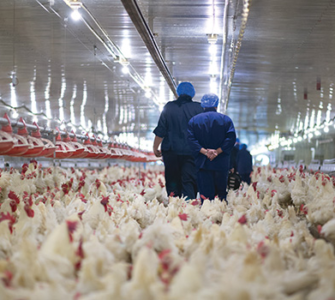Hurricane Florence and the poultry industry: Coping with the aftermath
By Philip A. Stayer, DVM, MS, ACPV
Corporate Veterinarian
Sanderson Farms, Inc.
Back in 2005, our grow-out operations in Mississippi weathered the “storm of the century” when Hurricane Katrina made landfall near Waveland and carved a northeasterly path. Sanderson Farms applied what was learned from that natural disaster by updating its crisis-management plan. Then in September 2018, Hurricane Florence brought a “thousand-year flood” to our growers in North Carolina. That hurricane took waters to places and levels that couldn’t possibly be anticipated.
With Katrina, a lot of our contract farmers had structural damage due to wind, but with Florence, almost all the damage was due to flooding. After Florence blew through, we used private helicopters and drones to view flooded facilities. If we couldn’t see the propane tanks, we knew the fate of the feathered inhabitants was grave and that the houses were completely flooded. As it turned out, many of the tanks had floated away.
Our hatcheries, processing plants and feed mill in North Carolina were spared, but Florence flooded 70 of 880 broiler houses on our growers’ farms. Approximately 2.1 million chickens in those houses drowned. Approximately 1.35 million were in the St. Pauls, North Carolina, big-bird deboning division, and about 755,000 birds were associated with the Kinston, North Carolina, tray-pack division.
It was a huge relief that all Sanderson Farm employees and contract family farmers made it through the storm alive, but many of them suffered huge losses — primarily their homes — due to flooding.
In preparation for the storm, Sanderson distributed as much feed and fuel as feasible to its contract growers. No farms ran out of feed, but some rationing was necessary until more supplies could be delivered, so for a time, broilers couldn’t eat ad libitum as usual.
Post-storm
Deliveries resumed after our folks made sure roads were safe. Boats may have been more helpful than trucks, but trucks were all that were available.
Processing plants were idled for several days — not only because of closed roads but also to give workers time to tend to personal matters. Unlike Katrina, when some farms were without power for up to 4 weeks, electric power service was restored quickly throughout eastern North Carolina after Florence. Only the St. Pauls hatchery had to operate on generator power for several days. The Kinston hatchery never lost power, nor did the Kinston feed mill, although the feed mill has a large generator on site that could have kept the facility working if need be.
Many growers with flocks that didn’t drown had generators to use during the electric outage, but they weren’t big enough to power all the equipment. Flocks therefore couldn’t be kept as cool as desirable during the late-summer heat, when daytime temperatures maxed out over 90° F (32° C). Thankfully, these flocks suffered no lasting ill effects and otherwise were managed appropriately and according to Sanderson’s animal-welfare policy.
The only post-storm health problem among surviving birds was Staphylococcus infection in replacement breeders and breeder chickens, which we attributed largely to the stress caused by changes in the daily routine.
Clean-up
Clean-up efforts after Florence consisted primarily of helping family farmers remove mortalities from their houses so they could get back to the business of tending flocks. Sanderson arranged for third-party contractors to deliver materials and run heavy machinery when needed by farmers. Biosecurity programs were maintained as much as feasible, but there was less concern than usual about people coming onto farms that had flooded since there were no live chickens left to protect.
Burial wasn’t an option due to the shallow depth of eastern North Carolina’s water table, and landfills won’t accept the volume of organic material associated with ground-reared poultry. Even without a flood, catastrophic mortality events are handled by above-ground composting, which starts inside the poultry house. First chicken house floors are covered with several loads of carbon material, like pine shavings, until the house contents are dry enough to turn in place. That takes about 2 weeks.
Once the house contents are moved outside, more carbon source is added and composting is finished. North Carolina’s Department of Agriculture and Consumer Services helped with this task, which helped locate materials and the expertise needed to compost drowned flocks. All told, North Carolina spent between US $11million and $13 million — primarily for sawdust — to compost the estimated 4 million chickens and turkeys lost in the flood. It sounds like a lot, but the state reportedly remained well under its budget of US $20 million, and it’s expected that most of the expense will be reimbursed by the federal government.1
Once houses were emptied, they were washed down, disinfected and new litter was brought in. Flooded houses had to replace at least some feeding-equipment components. Fortunately, wiring, computers and drinker systems were functional after dry-out and cleaning. It took over 1 month to get those houses back to normal production.
Lessons learned
The interruption in business due to Hurricane Florence meant some broiler flocks intended for processing at 59 days grew up to 70 days. Both the Kinston and St. Pauls processing plants were forced to operate additional days to catch up.
Our company is still dealing with the effects of operational interruptions associated with Florence, but we are diligently working toward getting back to business as usual. Based on our experience, I would advise all poultry producers large and small to have a disaster-response plan in place that includes contact names and numbers for anyone who can help when a natural disaster hits. Help might include routine supplies as well as equipment such as generators, generator parts, heavy equipment, etc. When a storm is brewing, it’s a good idea to talk to those contacts well before landfall and have arrangements in place for whatever help may be needed before and after the storm.
We’ve learned that while it’s essential to have a crisis-management plan, it’s also important to maintain flexibility so the plan can be adjusted to meet the unique situations that each natural disaster brings. We’ve also learned that there’s nothing like enduring a stressful event to strengthen a team and indelibly mark those who survive.
1. High cost to compost poultry after Hurricane Florence. November 14, 2018. WATTAgNet.com. https://www.wattagnet.com/articles/36164-high-cost-to-compost-poultry-after-hurricane-florence. Accessed November 14, 2018.
Editor’s note: The opinions and advice presented in this article belong to the author and, as such, are presented here as points of view, not specific recommendations by Poultry Health Today.
Posted on December 13, 2018
















